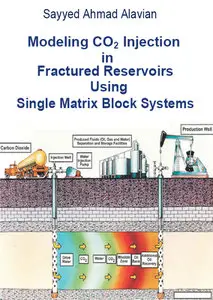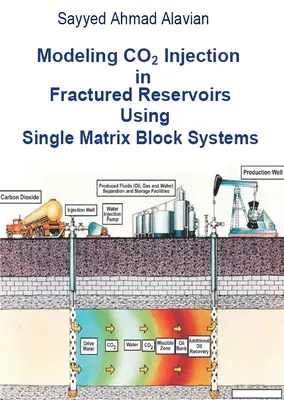"Modeling CO2 Injection in Fractured Reservoirs Using Single Matrix Block Systems" by Sayyed Ahmad Alavian
NTNU | 2011 | ISBN:n/a | 274 pages | PDF | 15 MB
NTNU | 2011 | ISBN:n/a | 274 pages | PDF | 15 MB
In this thesis, CO2 injection in matrix/fracture systems has been studied using finely-gridded compositional simulator representing a single matrix block. Three laboratory experiments were modeled to investigate whether CO2 injection fracture-matrix system could be simulated using commercial simulators include basic fluid flow physics, phase behavior, and molecular diffusion.
A key result is that diffusion can have an important effect on oil recovery, and that this effect varies with matrix block size and CO2 injection rate. For the field-scale matrix/fracture systems, diffusion can have a significant effect on the rate of recovery, with the effect becoming noticeable for low reservoir pressures and/or matrix block sizes less than ~40 ft.
Table of Contents
Abstract
Acknowledgements
List of Paper
Table of Contents
List of Tables
List of Figures
Nomenclature
Chapter 1 Introduction
1.1 Background
1.2 Thesis Outline
1.3 Reference
Chapter 2 Fundamentals and C Calculations
2.1 Introduction
2.2 Diffusion
2.2.1 Diffusion Coefficient
2.2.2 Diffusion Coefficient in Multicomponent System
2.2.3 Diffusion Coefficient in Porous Media
2.3 Relative Permeability and C'apillar>r Pressure Curve
2.3.1 Three Phase Relative Permeability
2.3.2 Capillar}' Pressure Scaling with IFT
2.4 Minimum Miscibility Condition
2.4.1 MMP calculation
2.5 Numerical Gridding
2.6 Reference
Chapter 3 Modeling CO2 Injection in Kaiimaie Fractured Chalk Experiment
3.1 Introduction
3.2 Rock and Fluid Properties
3.3 Experimental Procedure
3.4 Uncertainties and error sources
3.5 Model Description
3.6 Matching Experimental Data
3.6.1 Fracture Permeability
3.6.2 Equilibrium Gas Injection Rate
3.6.3 CO2 Injection Rates
3.6.4 Surface Separation
3.6.5 Regression Parameters
3.7 Recovery Mechanism
3.8 Designing Fractured Reservoir Experiments using CO2
3.9 Conclusions
3.10 Reference
Chapter 4 Modeling CO2 Injection in Danish Fractured Chalk Experiment (Sw=0%)
4.1 Introduction
4.2 Rock and Fluid Properties
4.3 Experimental Procedure
2.4.1 MMP calculation
2.5 Numerical Gridding
2.6 Reference
Chapter 5 Modeling CO2 Injection in Danish Fractured Chalk Experiment (Sw=26%)
5.1 Introduction
5.2 Rock and Fluid Properties
5.3 Experimental Procedure
5.4 Model Description
5.5 Matching Experimental Data
5.6 CO2 Injection Rate Effect
5.6.1 Oil Recovery
5.6.2 C02 Map Profile
5.7 Grid Sensitivity
5.8 Diffusion Coefficients Effect
5.9 Conclusions
5.10 Reference
Chapter 6 CO2 Injection in Naturally Fractured Resenoirs - Haft Kel Study without Diffusion
6.1 Introduction
6.2 Description of Model
6.3 Grid Sensitivity
6.4 Prediction of Minimum Miscibility Pressure (MMP)
6.5 Injection-Gas Mechanism
6.5.1 Equilibrium Gas in a Single Matrix Block
6.5.2 Mechanism of CO: m a Single Matrix Block
6.5.2.1 COi Lighter Than Oil
6.5.2.2 CO2 Heavier Than Oil
6.6 Injection-Gas Effect
6.6.1 C02-Dilution Effect
6.6.2 Tertiary Recovery by COi Injection
6.6.3 Reservoir-Pressure Effect
6.7 Matrix-Block Height Effect
6.8 Matrix-Block-Permeability Effect
6.9 Block-to-Block Interaction
6.10 Conclusions
6.11 References
Chapter 7 CO2 Injection in Naturally Fractured Resen oirs - Lab and Field Modeling Studies with Diffusion
7.1 Introduction
7.2 Description of Matrix.Fracture Models
7.2.1 Haft Kel Field-Scale Model
7.2.2 Laboratory Model
7.3 CO 2 Displacement Mechanism
7.3.1 Lab Test Recovery Performance
7.3.2 Field-Scale (Haft Kel) Recovery Performance
7.4 Reservoir Pressure Sensitivity
7.4.1 Core Model
7.4.2 Field-Scale Matrix
7.5 Matrix Block Permeability Sensitivity
7.6 Matrix Block Size Sensitivity
7.7 Injection Rate Sensitivity
7.8 Conclusions
7.9 References
Appendix A: Simulator Input Data Sets
Appendix B: Papers
with TOC BookMarkLinks



